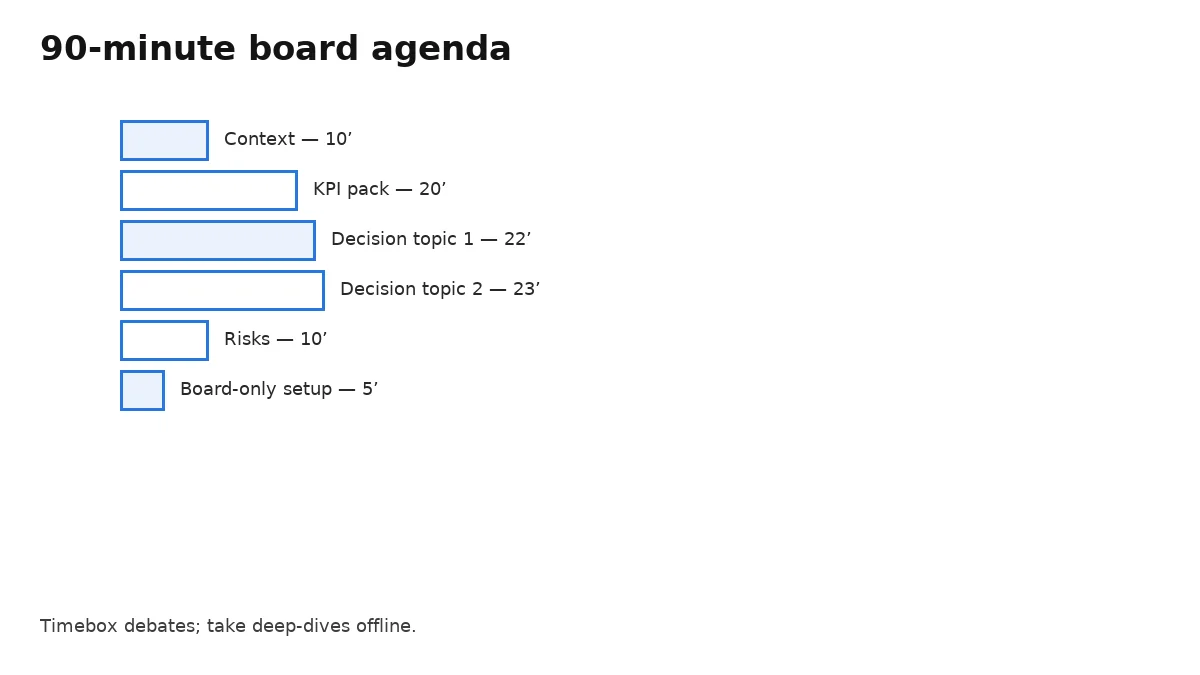Founder‑friendly board cadence, agenda, pre‑reads, KPI pack, decisions log, and a 90‑minute meeting flow—with templates and diagrams.
Early‑stage boards work when they’re lightweight, candid, and focused on decisions. This playbook gives you a 90‑minute agenda, a pre‑read and KPI pack structure, a decisions log, and governance hygiene—so the board helps you ship faster rather than manage the meeting.
Key takeaways: Ship a tight pre‑read 48 hours before, keep the meeting to 90 minutes, track decisions/owners in one log, and close with next steps and risks. Use a standard KPI pack so trends are obvious.
Same structure, tight pre‑read, clear decisions.
Send a pre‑read, run a 90‑minute meeting, document decisions and owners, and run a short follow‑up. Same structure every time.
Agenda: (1) What changed since last time; (2) KPIs & runway; (3) Two decision topics; (4) Risks; (5) Board‑only. Close with a recap of decisions, owners, and dates.
Quarterly is typical post‑seed; monthly if the company is moving fast or mid‑raise. Fix a single time and circulate a 12‑month calendar.
Send the pre‑read 48 hours prior; late materials lead to tactical meetings. Record minutes and store them with consents in your corporate folder.
One deck or doc, 8–12 pages: context, highlights/lowlights, KPI pack, decisions required, risks, and appendix.
KPI pack: revenue/ARR, growth efficiency, retention/cohorts (if SaaS), burn & runway, hiring plan vs actuals, product velocity. Use the same charts each meeting; annotate exceptions and one‑offs.

Define metrics once. Provide the formula, source, and owner next to the chart so discussions stay on substance, not calculation.
Examples: ARR, Net New ARR, Gross Margin, Burn Multiple, CAC Payback, Magic Number, NPS, Activation Rate, Uptime. Link each to the metric dictionary or BI chart.

10’ context, 20’ KPIs, 45’ two decision topics, 10’ risks, 5’ board‑only setup. Timebox the big debates.
Nominate a decision owner for each topic with a brief, options, and a recommendation. Capture the decision live in the log.

One running document with fields for decision, owner, due date, and status. Review at the start of each meeting.
Include a ‘what we tried/learned since last time’ note to build a continuous learning loop. Keep a separate list for board requests to the team.
Record minutes, compile written consents, maintain an insider list during financings, and review access to board materials.
Store these in your corporate folder with consistent names and dates. Confirm who sees board materials from investor firms (partners vs associates).
Manage expectations in 1:1s; use the meeting for decisions, not surprises.
Keep a running memo of the 3–5 decisions you’ll want input on over the next quarter. Align on what ‘good’ looks like for each.
If you host investor updates publicly, keep INP ≤200 ms, LCP ≤2.5 s, CLS ≤0.1 to preserve credibility.
Use static exports for charts; compress images; reserve embed sizes to avoid layout shifts.
Related reads: Finance Stack (GCC), UAE ESOP Plan, Diligence Prep Checklist.
Promise a 48‑hour window and keep it.
Circulate the pre‑read two days in advance with a short email: “Ask questions async in comments; we’ll reserve meeting time for decisions.” Late material is the #1 cause of tactical, meandering boards. If you miss the window, delay the decision topic, not the review.
Choose the format that fits your team’s writing culture.
Slides are quicker to scan; docs force clarity and survive better as a record. Whichever you pick, keep a consistent table of contents and link every chart to its source. Include a one‑page “What changed” summary up front.
Bound the scope and time.
Use 5 minutes in the main meeting to set up a separate 20–30 minute board‑only session: topics generally include compensation, performance issues, or sensitive legal items. The CEO should propose the agenda and step out; circulate any decisions via written consent after.
Keep directors warm with a monthly pulse.
Spot and fix these early.
One page, three options, recommended path.
Lift the debate out of the room.
Include a link to a living doc with fields: metric name, definition/formula, source query/report, owner, update cadence, and edge cases. Note if the metric is preliminary or audited.
Small and helpful beats big and performative.
Seed–A boards are often 3–5 directors. Keep observers limited and aligned on speaking norms. Invite functional leads only for their topics; otherwise keep the room small to reduce social overhead.
Revisit the pack annually.
Once a year, audit the KPI set and the agenda structure. Remove vanity metrics, add any new north‑stars, and refine the decisions brief template based on what actually drove outcomes.
Board‑only: time for directors without management present. Consent: written approval between meetings. RACI: model for decision roles. Runway: months of cash at current burn.
Quick answers on early‑stage board operations.
Tune the middle block to the moment.
Keep it factual, not stenographic.
Date/time; attendees; approvals (prior minutes, options, consents); summary of KPI review; decisions with votes (if any); actions with owners and dates; board‑only topics; adjournment time. Circulate within a week for approval.
Want a board cadence that speeds decisions and fundraising?


© EA Partners 2025. All Rights Reserved.